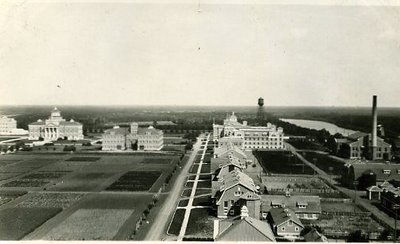Manitoba Agricultural College
After 1905 the agricultural education movement on the prairies was strengthened when the province of Manitoba established the Manitoba Agricultural College.
It might be argued that the objectives of the College had less to do with teaching students how to farm as then with equipping those who already knew how to farm with the scientific and management tools to make them better farmers. The College offered a core curriculum of coures in horticulture and field husbandry, agricultural engineering, animal husbandry, and natural history. In addition to these practically oriented courses, programmes were offered in the fields of agricultural economics, accounting and farm management, courses which reflected the increasing professionalization of farming.
Alongside the faculties that taught farming practises, MAC offered course in Household Sciences and Home Economics. This home economics division offered courses in foods and nutrition, clothing and textiles, physiology and hygiene and institutional management to women, and reflected a growing professionalization of the domestic sphere in rural society.
In addition to being a centre of teaching, the College was a centre of research and experimentation. College agronomists conducted research into agricultural techniques, inventing and improving machinery, determining the optimal methods for weed and insect control, tillage and ploughing, and crop rotation.
The College was also a primary instrument of agricultural education beyond its own classrooms and laboratories, and it counted among its objectives to bring news of agricultural developments to the attention of established farmers. The College sponsored field experiments and demonstration crops on private farms. It conducted extension courses, lecture series and practical demonstrations at which farmers could learn more about soil and moisture conservation, traction engineering, seed cleaning, and other aspects of modern farming. Between 1912 and 1914, these educational programmes took to the rails, as the College co-operated with the Agricultural Extension Services to send two Better Farming Trains across the province.

Since in Minitonas in 1924 the Strachans were raising row crops (onions, potatoes, raspberries) with horse-drawn machinery (the kind on which one sits, holding reins) and living in modest houses, Bruce must have been in a state of shock for the first months at Manitoba Agricultural College in Winnipeg. Huge blocky buildings sitting in straight lines south of Winnipeg were so new there was neither lawn nor landscaping. The campus looks rather Soviet. The first thing he did was go to the top of each building and take a photo of the other buildings from the top. The first impulse of most folks would be to stand before the entrance and take a photo looking up at the building, but I don’t see a single photo like that. Bruce was a freshman at age 23, evidently preferring to look at the larger layout -- and perhaps to keep some distance.

But the phenomenon of the Edenic, protected, inside over-against the monolithic, stony, forbidding outside is present at its most extreme in the horticulture building with its greenhouses. Inside is lush and blooming summer, nothing like the subzero of outdoors. The seduction of such a sheltered place cannot be overestimated.


In 1925 Glenn also attends college here and thus is able to photograph his big brother Bruce at the top of the 100 foot CKY radio tower while the latter photographs the campus from his perch. At the end of the first term, Bruce averages 82% and Glenn averages 84%. These scores are the highest in their respective classes. The next highest scores are several points lower. Despite their literal high-jinks, they work hard.
I don’t know whether they were atypically older or whether this was a common phenomenon in that setting, but I do believe they were proud, nearly to the point of arrogance. What kept the lid on them was a strong near-communist sense of social responsibility and political obligation to others. They had a keen sense of community and neighborhood, for the excellent reason of having saved each other over the years. This was the Roaring Twenties, sure enough, (probably rather muffled in Winnipeg, though even today that city has an avant garde edge), but there was also an element like the Sixties -- an appetite for experiment and a Peace Corps-like drive to reform and develop. My father was enthralled by people like Bertrand Russell and Margaret Sanger, but his idealism was not theoretical so much as it was practical. Rodale, the organic gardener, was in there with Freud. The prairie Strachans knew what hard times were like.
Traveling home on the train from school, my father’s resources had been reduced to 26 cents. Combining his knowledge of nutrition with a desire for value, he spent the money on a big bag of redskin peanuts to eat on the long trip. Throughout his life he kept a little cache of redskin peanuts as a buffer against starvation. I do the same.
No comments:
Post a Comment